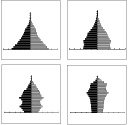Age-structural Political Demography
 In the United States, economic demography and age-structural political demography have similar intellectual roots. The earliest theoretical exposition of the effects of population age structure on the state was published in 1958 by Ansley Coale and Edger M. Hoover. [1] Coale and Hoover focused on the relative decline in the ratio of childhood dependents to potential workers, and thus the opportunity for accumulating savings and for greater per-child investments in education, both by the household and the state—effects that were later quantified by research (in more than 40 countries) on life-cycle income, consumption and transfers conducted by Ronald Lee and Andrew Mason.[2] Because declining fertility ultimately slows workforce growth, Coale and Hoover also foresaw opportunities for reduced competition among young adults vying for jobs—an effect first observed empirically by Richard Easterlin in the late 1980s.[3]
In the United States, economic demography and age-structural political demography have similar intellectual roots. The earliest theoretical exposition of the effects of population age structure on the state was published in 1958 by Ansley Coale and Edger M. Hoover. [1] Coale and Hoover focused on the relative decline in the ratio of childhood dependents to potential workers, and thus the opportunity for accumulating savings and for greater per-child investments in education, both by the household and the state—effects that were later quantified by research (in more than 40 countries) on life-cycle income, consumption and transfers conducted by Ronald Lee and Andrew Mason.[2] Because declining fertility ultimately slows workforce growth, Coale and Hoover also foresaw opportunities for reduced competition among young adults vying for jobs—an effect first observed empirically by Richard Easterlin in the late 1980s.[3]
Job competition and under-employment among young adults in countries with youthful populations served as the basis for Herbert Möller’s theory, published in the late 1960s, explaining the vulnerability of states with youthful age structures to militarism and armed conflict in the 19th century.[4] This theory was pursued again, in more detail, by Jack Goldstone in his research on the emergence of large youthful cohorts in early modern Europe and Asia, and their link to revolution.[5] Goldstone’s research was later complimented by Christian Mesquida’s research on the relationship between the ratio of young-adult men to older adult men, and its association with the intensity of late-20th century conflict.[6] In 2006, Henrik Urdal published his research on age-structure’s statistical effect on the onset of conflict.[7] In 2016, Omer Yair and Dan Miodownik determined that the “youth-bulge effect” was pertinent only to non-ethnic conflict, while ethnic conflict appeared unresponsive to age structure [8].
In 2008 and 2009, Richard Cincotta demonstrated an age-structural effect on the rise and stability of liberal democracy [9], predicting the rise of a liberal democracy, between 2010 & 2020, of “at least one, maybe two” non-democratic states in North Africa (Morocco, Algeria, Tunisia, Libya, Egypt) and in the northwest corner of South America (Venezuela, Colombia, Ecuador). The first part of this prediction was realized in 2015, with Freedom House’s assessment of Tunisia as FREE.
[1] Ansley J. Coale, and Edgar M. Hoover. 1958. Population Growth and Economic Development in Low-Income Countries: A Case Study of India’s Prospect. Princeton: Princeton University Press.
[2] Ronald Lee and Andrew Mason. 2011. Population Aging and the Generational Economy: A Global Perspective. Oxon, U.K.: Edward Elgar.
[3] Richard A. Easterlin. 1987. Birth and Fortune: The Impact of Numbers on Personal Welfare. Chicago: University of Chicago Press.
[4] Herbert Möller. 1968/69. “Youth as a Force in the Modern World.” Comparative Studies in Society and History 10(3): 237-260.
[5] Jack A. Goldstone. 1991. Revolution and Rebellion in the Early Modern World. Berkeley: Univ. of California Press.
[6] Christian G. Mesquida and Neil I. Wiener. 1996. “Human Collective Aggression: a Behavioral Ecology Perspective.” Ethology and Sociobiology 17:247-262.
[7] Henrik Urdal. 2006. “A Clash of Generations? Youth Bulges and Political Violence.” International Studies Quarterly 50:607-629.
[8] Yair, O.and D. Miodownik. 2016. “Youth bulge and civil war: Why a country’s share of young adults explains only non-ethnic wars ” Conflict Management and Peace Science 33(1):25-44.
[9] Cincotta, R.P. 2008/09. “Half a Chance: Youth Bulges and Transitions to Liberal Democracy.” Environmental Change and Security Program Report 13:10-18; Cincotta, R.P. 2008. “How Democracies Grow Up: Countries with Too Many Young People May Not Have a Fighting Chance for Freedom.” Foreign Policy (165):80-82.
